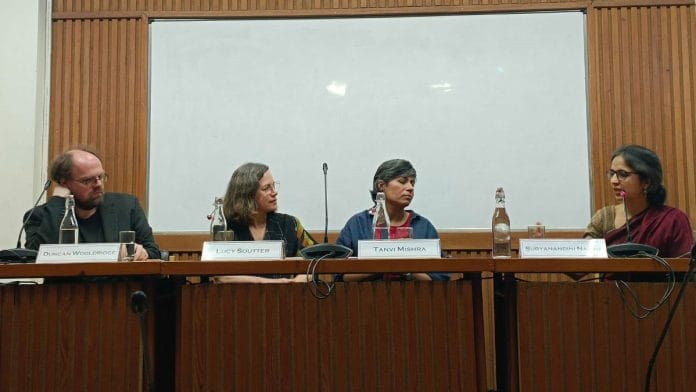New Delhi: Photography travelled the world with the colonisers, but it also became a tool of post-colonial nationalism, said London-based artist and author Lucy Soutter who was in Delhi recently. She was speaking at a discussion on The Routledge Companion to Global Photographies—a photobook offering a transnational discussion grounded in dialogue between authors and editors from diverse locations and contexts on photography.
The event, titled ‘Global Photographies: Transnationality/Regionality’, held at the India International Centre on 28 February had other speakers such as Duncan Wooldridge, Reader in Photography at Manchester Metropolitan University, and photo editor, curator, and writer Tanvi Mishra.
They gave insights about how photobooks are perhaps one of the most rarely shared yet intensely engaging forms of media throughout the globe. The book, published by Routledge, has been edited by Lucy Soutter and Duncan Wooldridge.
Photography for future encounter
The photobook includes a range of topics at the intersection of photography and climate. It also explores gender, queer theory, and photography emerging in Latin America to the role of materiality in photography from a global perspective.
Wooldridge, in the book, addresses the changing and evolving nature of photography. He explained that photography is not a static or fixed record but rather a process that is continuously unfolding.
“Images are created not only for ourselves or for the present but also for future encounters,” said Wooldridge, adding that “we make an image which is made for an encounter that is yet to come.”
Woodridge also explained how the project, The Global Photographies Network, emerged as a response to the traditional photo-historical narratives. “Global Photographies is something that began as a resistance to the arrest of the image,” he said.
With no in-person lectures during the pandemic, the project emerged as a way to rethink and share knowledge. A group of academics began working together to rethink photography beyond the Western perspective.
While Wooldridge stressed on the interconnectedness of the art, Mishra’s work focussed on photography and caste. She showed a photograph of a Dalit funeral on a projector, illustrating how different people in India present the same thing in different ways through photography.
Mishra compared the works of two photographers, Palani Kumar and Vishal Kumaraswamy, both of whom focus on caste and death, but in different ways and perspectives.
Kumar documents the deaths of manual scavengers, aiming to challenge public indifference toward marginalised groups. His work serves as a record that resists the desensitisation to such issues. In contrast, Kumaraswamy’s work looks at Dalit funeral processions in India. He doesn’t look at photography as representation but talks about the movements that take place in a funeral procession.
“I choose to look at caste because there’s a statistic. When I was researching for the paper, it said every 18 minutes a crime is committed against an individual from an elite group against suppressed caste groups,” said Mishra.
Also read: Nehru flew to Beijing in 1954 hoping for peace. He was proved wrong
Travelling photography
Photographs travel throughout the world and their meanings and perspectives change. “When photography travels internationally, how much of its original meaning can it retain, and how much will it be automatically reframed by its new context and audience?” asked Soutter.
Soutter also questioned the idea of calling photography a universal language and assuming it can be easily understood across cultures. “We don’t all want to be speaking photography in Esperanto. On the flip side, there is the idea that these kinds of curatorial practices might be feeding the market with commodified difference and exoticism,” she said, following it up with an example.
An artist’s work, originally about the traditional Chinese landscape painting style called Shan Shui, once ended up being perceived merely as a representation of “Chineseness” at an international fair.
Soutter concluded with a reflection and concern, suggesting that understanding an artwork across cultures requires more than just a simple transfer of meaning.
“You can’t just take a text, a written text, or any other kind of cultural text from one culture and force it into the language of another. Along the way, there are all kinds of subtleties and nuances that need to be considered,” she said.
(Edited by Aamaan Alam Khan)






